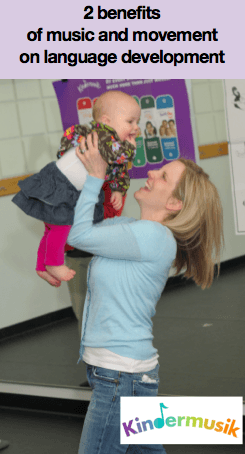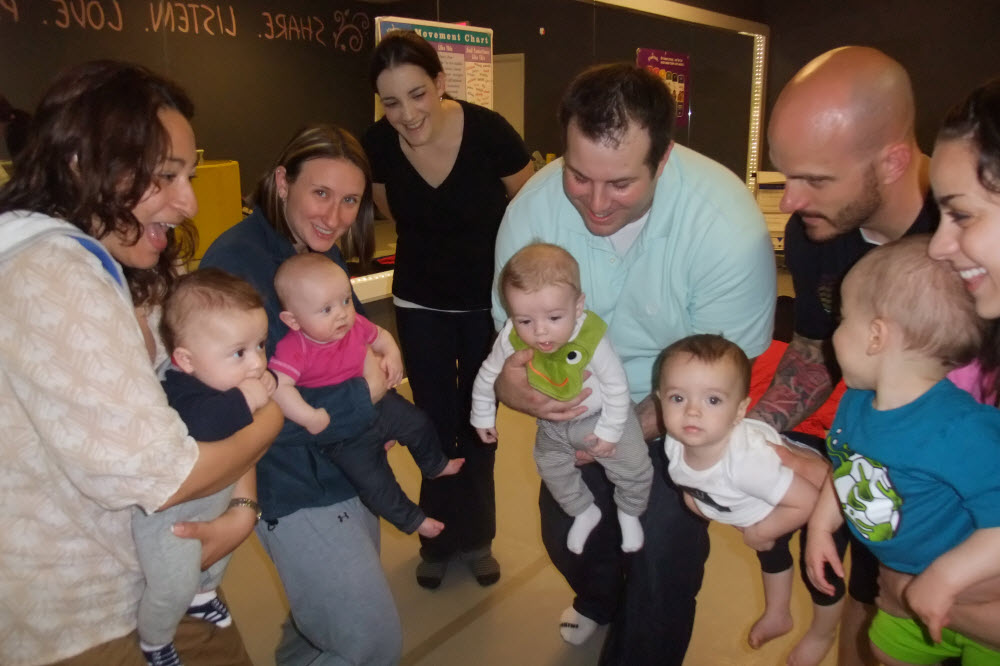 This week, Kindermusik International announced our newest curricula for babies and young toddlers through a press release, which continues to be shared through parenting and education websites, newsletters, and social media channels.
This week, Kindermusik International announced our newest curricula for babies and young toddlers through a press release, which continues to be shared through parenting and education websites, newsletters, and social media channels.
Consider sharing with your local community and press!
New Music and Movement Classes from Kindermusik Engage Babies and Toddlers
Cuddle & Bounce and Sing & Play offer opportunities for young children to bond with parents while learning musical concepts and furthering brain development
GREENSBORO, NC – December 3, 2013 – Music and movement classes can spark learning in young children, and when done in conjunction with a parent, can help build bonds between parent and child. Parents seeking early development opportunities for children as young as newborns should check out two new classes offered by Kindermusik International. The classes Cuddle & Bounce, for children from birth to one year of age, and Sing & Play, for children from one to two years of age, use music and movement to nurture and guide learning. Parents can sign-up to try a free class by visiting Kindermusik.com.
During weekly classes, parents and children engage in a mix of activities such as instrument exploration, dancing, singing, the learning of musical concepts like steady beat, tempo, and more. A licensed Kindermusik educator shares the developmental benefits behind the activities, and provides access to Kindermusik@Home online parenting resources including music and stories from class, tips for parents on how to communicate with their babies, and specific ideas on how to incorporate music and movement activities into the families’ daily routines and rituals. These classes for babies and toddlers are just the beginning of the Kindermusik journey, as their program extends through age seven.
Cuddle & Bounce celebrates the thrilling journey of a baby’s first year of life, focusing on:
- Language and Vocal Development – Babies’ early language skills are nurtured as they imitate sounds, engage in lots of give-and-take conversations, and add to communicative abilities through sign language.
- Brain Development – Through every movement, a baby’s brain synapses and the connections between neurons are created and strengthened.
- Large and Small Motor Skills – Movement through music activities support stretching, kicking, rolling, crawling, sitting and standing independently will enhance large motor skills; playful activities such as reaching for or grasping objects will aid small motor skills.
- Social-Emotional Development – Through lots of cuddling, playing, humming, and dancing, Kindermusik activities help build and strengthen parents’ relationship with children. Side-by-side play and group dance activities with other parents and children provide the important benefits of safe and early interactions with the wider social world.
- Musical Development – Together, parents and babies will explore simple, baby-safe percussion instruments. Throughout hundreds of different Kindermusik music and movement activities, babies receive an early introduction to the songs, sounds, rhythms, and tempos of music from around the world.
The Sing & Play curriculum includes:
- Movement & Physical Development – Walking, jumping, marching, dancing, bouncing, and wiggling is fun, and strengthens young muscles and bones, improves balance, and helps new walkers be aware of what their bodies can do.
- Exploration Time – A child’s natural curiosity is stimulated in an inviting environment full of specially designed instruments, textures, sounds, movements, interesting objects, and baby-safe props.
- Language Development – By exploring new words and imitating sounds, young toddlers gain vocabulary and communication skills.
- Instrument play and Musical concepts – Age-appropriate experiences with child-safe instruments enhance a sense of rhythm and steady beat, develop a keen awareness of the distinguishing qualities of sound, and encourage spontaneity and creativity. Even the littlest musicians and their parents benefit from early exposure to basic music fundamentals like loud and quiet, musical form, tempo, timbre, steady beat, and more.
"Cuddle & Bounce and Sing & Play classes give parents new opportunities to engage in safe, fun, and developmentally appropriate music-and-movement experiences with their very young babies and toddlers," said Debby Pool, vice president of product development for Kindermusik International. “We are excited to add these two new curricula to our offerings, and we are confident that these classes will give babies and new walkers a great early start in many critical domains of development and learning.”
To take advantage of these early childhood music programs, which later feed into Kindermusik International’s curricula for children through age seven, visit Kindermusik.com to find a class near you and try a class for free.
About Kindermusik International
Kindermusik International is the world’s leading provider of music, movement and literacy programs for young children, enjoyed by 2 million plus families in more than 70 countries. For more than 30 years, Kindermusik has helped children and their families discover how music can enrich their lives and lay the foundation for a lifetime love of learning. Kindermusik offers developmentally-specific educational programs for children ages newborn to seven. Kindermusik curriculum is taught by the best educators in the best schools and studios world-wide. Visit Kindermusik.com to find out more about Kindermusik’s music classes for kids and early childhood curriculum.
Connect with Kindermusik:
Facebook: Facebook.com/Kindermusik
Google+: Plus.Google.com/+Kindermusik
Pinterest: Pinterest.com/Kindermusik
Twitter: @Kindermusik
YouTube: Youtube.com/KindermusikRocks
Contacts:
Shellie Foriska
Kindermusik International
720-206-6293
sforiska@kindermusik.com
Lauren Burke
KEH Communications
410-975-9638
Lauren@kehcomm.com
###
 almost exclusively on what they hear in order to acquire language. Children’s brains make a connection based on what they experience (being lifted high or twirling around) and hear (“up” or “twirl”). So, when a parent of caregiver lifts a child high “up, up in the sky” or “twirls around like a leaf” while singing the songs in Kindermusik class, young children learn the word and understand the concept. Later, children will discover those words correspond to marks on a page which eventually leads to letter recognition and reading.
almost exclusively on what they hear in order to acquire language. Children’s brains make a connection based on what they experience (being lifted high or twirling around) and hear (“up” or “twirl”). So, when a parent of caregiver lifts a child high “up, up in the sky” or “twirls around like a leaf” while singing the songs in Kindermusik class, young children learn the word and understand the concept. Later, children will discover those words correspond to marks on a page which eventually leads to letter recognition and reading. Come experience for yourself the benefits of music! Contact a local Kindermusik educator and visit a class.
Come experience for yourself the benefits of music! Contact a local Kindermusik educator and visit a class. 



 for babies
for babies
 This week, Kindermusik International announced our newest curricula for babies and young toddlers through a press release, which continues to be shared through parenting and education websites, newsletters, and social media channels.
This week, Kindermusik International announced our newest curricula for babies and young toddlers through a press release, which continues to be shared through parenting and education websites, newsletters, and social media channels.